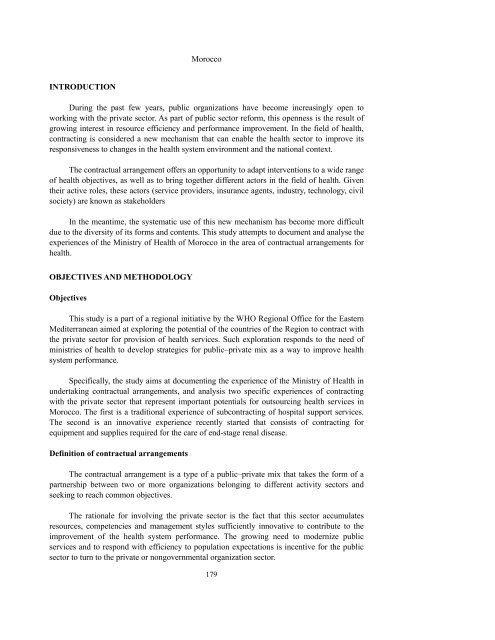The role of contractual arrangements in improving health sector ...
The role of contractual arrangements in improving health sector ...
The role of contractual arrangements in improving health sector ...
You also want an ePaper? Increase the reach of your titles
YUMPU automatically turns print PDFs into web optimized ePapers that Google loves.
INTRODUCTION<br />
Morocco<br />
Dur<strong>in</strong>g the past few years, public organizations have become <strong>in</strong>creas<strong>in</strong>gly open to<br />
work<strong>in</strong>g with the private <strong>sector</strong>. As part <strong>of</strong> public <strong>sector</strong> reform, this openness is the result <strong>of</strong><br />
grow<strong>in</strong>g <strong>in</strong>terest <strong>in</strong> resource efficiency and performance improvement. In the field <strong>of</strong> <strong>health</strong>,<br />
contract<strong>in</strong>g is considered a new mechanism that can enable the <strong>health</strong> <strong>sector</strong> to improve its<br />
responsiveness to changes <strong>in</strong> the <strong>health</strong> system environment and the national context.<br />
<strong>The</strong> <strong>contractual</strong> arrangement <strong>of</strong>fers an opportunity to adapt <strong>in</strong>terventions to a wide range<br />
<strong>of</strong> <strong>health</strong> objectives, as well as to br<strong>in</strong>g together different actors <strong>in</strong> the field <strong>of</strong> <strong>health</strong>. Given<br />
their active <strong>role</strong>s, these actors (service providers, <strong>in</strong>surance agents, <strong>in</strong>dustry, technology, civil<br />
society) are known as stakeholders<br />
In the meantime, the systematic use <strong>of</strong> this new mechanism has become more difficult<br />
due to the diversity <strong>of</strong> its forms and contents. This study attempts to document and analyse the<br />
experiences <strong>of</strong> the M<strong>in</strong>istry <strong>of</strong> Health <strong>of</strong> Morocco <strong>in</strong> the area <strong>of</strong> <strong>contractual</strong> <strong>arrangements</strong> for<br />
<strong>health</strong>.<br />
OBJECTIVES AND METHODOLOGY<br />
Objectives<br />
This study is a part <strong>of</strong> a regional <strong>in</strong>itiative by the WHO Regional Office for the Eastern<br />
Mediterranean aimed at explor<strong>in</strong>g the potential <strong>of</strong> the countries <strong>of</strong> the Region to contract with<br />
the private <strong>sector</strong> for provision <strong>of</strong> <strong>health</strong> services. Such exploration responds to the need <strong>of</strong><br />
m<strong>in</strong>istries <strong>of</strong> <strong>health</strong> to develop strategies for public–private mix as a way to improve <strong>health</strong><br />
system performance.<br />
Specifically, the study aims at document<strong>in</strong>g the experience <strong>of</strong> the M<strong>in</strong>istry <strong>of</strong> Health <strong>in</strong><br />
undertak<strong>in</strong>g <strong>contractual</strong> <strong>arrangements</strong>, and analysis two specific experiences <strong>of</strong> contract<strong>in</strong>g<br />
with the private <strong>sector</strong> that represent important potentials for outsourc<strong>in</strong>g <strong>health</strong> services <strong>in</strong><br />
Morocco. <strong>The</strong> first is a traditional experience <strong>of</strong> subcontract<strong>in</strong>g <strong>of</strong> hospital support services.<br />
<strong>The</strong> second is an <strong>in</strong>novative experience recently started that consists <strong>of</strong> contract<strong>in</strong>g for<br />
equipment and supplies required for the care <strong>of</strong> end-stage renal disease.<br />
Def<strong>in</strong>ition <strong>of</strong> <strong>contractual</strong> <strong>arrangements</strong><br />
<strong>The</strong> <strong>contractual</strong> arrangement is a type <strong>of</strong> a public–private mix that takes the form <strong>of</strong> a<br />
partnership between two or more organizations belong<strong>in</strong>g to different activity <strong>sector</strong>s and<br />
seek<strong>in</strong>g to reach common objectives.<br />
<strong>The</strong> rationale for <strong>in</strong>volv<strong>in</strong>g the private <strong>sector</strong> is the fact that this <strong>sector</strong> accumulates<br />
resources, competencies and management styles sufficiently <strong>in</strong>novative to contribute to the<br />
improvement <strong>of</strong> the <strong>health</strong> system performance. <strong>The</strong> grow<strong>in</strong>g need to modernize public<br />
services and to respond with efficiency to population expectations is <strong>in</strong>centive for the public<br />
<strong>sector</strong> to turn to the private or nongovernmental organization <strong>sector</strong>.<br />
179
















